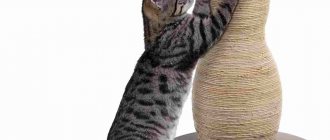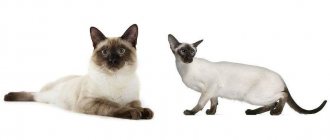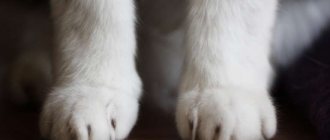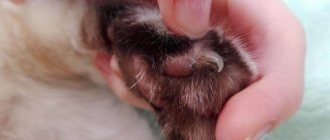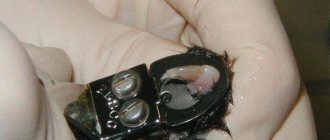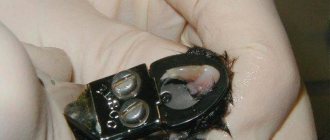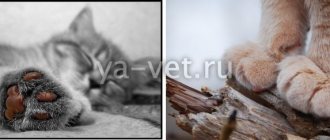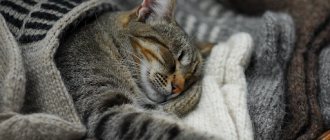A mustache is the hair that grows on a person's upper lip.
Everything is simple and clear. A cat is another matter. She has a mustache - and not a mustache at all, but rather transformed receptors, sensory organs that perceive the slightest changes in the environment.
A cat's whiskers - vibrissae (lat. vibrissae, from vibro - waver, wriggle) - long, hard, tactile hairs protruding above the fur. Vibrissae are several times longer and thicker than ordinary hair. The longer and more sensitive ones are located above the upper lip in four rows on either side of the nose, and the upper two rows can move independently of the lower ones. The shorter whiskers are located on the cheeks, on the chin and above the eyes, on the ankles of the front paws and on the tail, and they are also found between the pads on the paws.
Why does a kitten's whiskers break?
Does your kitten's whiskers break? This phenomenon cannot be ignored. Usually it is caused by harmless reasons that do not threaten the health and life of the baby. However, breaking off whiskers in small pets can also be caused by more serious factors that require urgent action. Every cat owner, even those who have never encountered this problem, should know why kittens' antennae break off.
Whiskers chewed by a cat
Broken whiskers on a small cat that has not yet been weaned from its mother may be the work of its paws, or rather teeth. Some cats, teaching kittens to live independently, bite off the babies' whiskers when they do not obey and play a lot of pranks. Maternal instinct tells four-legged mothers that this is the only way to calm their unruly cubs.
What kind of whiskers do cats have?
The main part of the vibrissae grows on the muzzle. They come in different lengths and perform different functions.
Vibrissae are divided into the following groups:
- supraorbital (located above the eyes),
- buccal (located on the cheeks),
- mystical (located on the sides of the mouth),
- mandibular (located on the chin).
Mystical vibrissae are conventionally divided into macrovibrissae and microvibrissae. Macrovibrissae are long and thick whiskers that usually grow to the sides and are needed so that the pet can “scan” the space around the head. They grow in four rows symmetrically on both sides of the muzzle. Each cat's pattern is unique, just like a human's fingerprint.
Microvibrissae are usually short, easily confused with regular hair, and grow downwards. They have a similar function - to read space, but microvibrissae allow cats to examine objects in more detail, while simultaneously using their senses of smell and taste.
In addition to the whiskers on their faces, cats have carpal whiskers. They can be seen on the back of a cat's paws. They help domestic predators in hunting. When a cat has caught game, the whiskers on its paws help determine whether the prey is moving and whether it is alive or not.
How do cat whiskers work?
When cats touch an object with their whiskers, they catch its outline. Signals are transmitted to the brain using nerve endings that are located in the bulb of each mustache. There are 100-200 nerve cells per whisker.
Receptors transmit information to the brain about the direction, speed and duration of whisker movement. This is how cats read the location, size, texture of an object and other information.
Normal for mustache loss
If a cat's whiskers fall out, this is not a reason to panic. First of all, you need to take a closer look at its behavior and see if a new whisker grows in place of the fallen whisker.
Most often, mustache loss is not associated with any abnormalities. Regardless of the molting period, they can be periodically renewed - old vibrissae fall out, and new ones appear in their place. The reason why a cat's whiskers fall out can be a fight with another animal or excessive curiosity, in which he comes too close to a burning fire.
Are vibrissae wool or hair?
These hard formations should rise above the entire coat, be mobile and elastic. It is important that they end with a tapered end like a sword. Only in this case are whiskers a sign of good cat health. If they are brittle, drooping and faded, this means that the cat is sick and at least lacks B vitamins, as well as minerals such as calcium, silicon, and phosphorus.
These formations are not wool, although they have a similar composition and structure. They cannot be called hair, since they are not so hard and sticking out in different directions.
Vibrissae are formations that have a common evolutionary origin with wool, hair, claws, nails, scales and even quills of porcupines and hedgehogs.
These long formations have hair bags, which makes them similar to human hair. However, unlike hair and wool, each vibrissa has an increased level of innervation.
Vibrissae hair bags surround venous cavities and a large number of nerve endings. This means that the vibrissae have all the characteristics of a sensory organ, which indeed they are.
Meaning of mustache
At the base of the cat's whiskers are muscles containing nerve endings. Each of them is connected in a certain way to the brain. At the slightest vibrations of the whiskers (vibrissae), the necessary information is transmitted at the impulse level. Scientists have found that through these hairs, representatives of the cat family have a three-dimensional specific vision of the world around them in the dark.
Table no. The meaning of whiskers and eyebrows for cats
Function
Meaning
How to help a pet who has lost its whiskers
There are no specially designed drugs or products to accelerate the growth of whiskers in cats. With a healthy hair follicle, the vibrissae grow on their own. There is no need for additional care. Veterinarians emphasize that there is no need to use any ointments or creams, this will not bring any benefit.
If it happens that your mustache breaks or falls off, you need to diversify your diet. It is advisable to include the following products in your daily menu:
- cottage cheese;
- vegetable oil;
- milk.
Already in the 3rd week, the hairs grow a couple of millimeters, which allows the four-legged pet to again adequately respond to the world around it. Over the next 4-10 weeks, the vibrissae acquire the required size, and their receptors are completely restored.
How do whiskers differ between cats and cats?
There are no distinctive features in the location and structure of the whiskers of cats and kittens. There are no gender differences, and the vibrissae are responsible for the same functions. Each animal can have a certain thickness and length individually. This feature is considered strictly genetic.
The size of the hairs depends primarily on how fortified and balanced the pet’s diet will be. Our ancestors believed that the length of the whiskers of pets was influenced by the number of mice caught. It is not without scientific basis, because it is thanks to hunting that cats constantly train their ability to concentrate and react quickly.
What happens if you trim your mustache
The consequences of losses are difficult to predict; they are varied and depend on individual characteristics, whether the cat is a street or domestic cat.
What happens if you cut off a cat's whiskers?
- Pets will begin to look for secluded places and be reluctant to communicate with the owner.
- Street - will have problems finding food, will begin to miss the victim more often, remain hungry until the whiskers manage to grow back.
Navigation disorders are the answer to the question of what will happen if cats' whiskers are trimmed. For some time, the animal will lose the ability to easily navigate the space around it.
- inability to walk in a straight line;
- frequent falls;
- collision with furniture;
- various injuries.
Failure in behavior is associated with the absence of habitual signals about obstacles and health hazards. Such deviations are not typical for everyone. In most cases, the problem manifests itself as difficulty in jumping, free orientation in the dark, or in unfamiliar surroundings.
Experienced breeders report the following deviations in the behavior of young animals and adult pets, which will happen if you cut off a cat’s whiskers:
- inappropriate behavior based on stress and fearfulness;
- lack of contact, withdrawal into oneself;
- lack of physical activity;
- increasing the amount of sleep.
Important! Comfortable conditions for a cat that has lost its whiskers will make it possible to reduce the risk of injury, but will not ensure its peace of mind.
Will they grow back?
During scientific research, parts of the test animals had their whiskers removed completely or partially. Behavioral studies have shown that pets are more likely to get stuck in narrow holes, miss them, and be unable to get into them. Such failures had a bad effect on the psyche, the cats began to be afraid and hide, giving up any attempts.
What can be done about this problem?
What should you do if your cat’s whiskers begin to fall out and break? The universal answer is this: the first and most important thing an owner can do for their pet is to calm down, pick up the animal and take it to the veterinarian. Under no circumstances should you try to cure this problem yourself, because most often mustache loss is a symptom, not a disease . In general, no special actions can be taken in this case - you should not comb your mustache or lubricate it with any oil, you just need to find the cause of this problem and eliminate it.
Further care for the animal if its whiskers have been cut off
Do lost whiskers grow back in cats: even after trimming the hairs on the eyebrows and chin, they will be restored in 14-21 days. There are no special means to accelerate their growth - doctors advise using multivitamin complexes specifically designed for animals. They allow hairs to grow faster and become thicker.
Natural recovery will occur provided that no damage to the hair follicle occurred at the time of loss of the mustache. Animal care includes:
- protecting it from hot objects: fireplaces, gas and electric stoves, candles;
- using a special cap will help reduce the risk of head injuries;
- if a pet is placed in a cage for a while, then it will not be able to accidentally harm itself;
- an injured animal should not be allowed out into the street - there it can get under the wheels of a car, fall from a height, crash and damage not only its paws, but also its head.
Each new haircut of the whiskers will cause aggression in the pet towards its tormentor. If there are children in the house, then they immediately need to be explained why there are hard hairs on the cat’s body and what the risk of losing them is.
Trimming whiskers will not make a cat look beautiful; they play a big role in choosing a partner and communicating with familiar and unfamiliar relatives. Having lost their sixth sense organ, animals cannot hunt or move through previously unexplored places. Nature has protected furry pets, but it will take a long time to recover from the loss, during which time they can suffer seriously. Any stressful situation does not pass without a trace, then you should not be surprised at an animal that is aggressively opposed to its own owners.
Pet owners want to know as much useful information and facts about their furry pets as possible. This knowledge helps not only to properly care for and prevent diseases, but also to better understand your mustachioed companion. Cat breeders are interested in a wide variety of questions, including what will happen if a cat’s whiskers are trimmed. Not everyone knows the true purpose of this organ and vaguely understands the consequences of its absence.
Read in this article
Mechanisms of application
Vibrissae help the cat to hunt, informing about the slightest changes in the position of the prey's body.
The kitten's large, light-colored curling whiskers activate the actions of the nerve endings - the tactile corpuscles. The base of the vibrissae is located in the blood sinus. Due to this, any fluctuation in the external environment increases and irritates the body. They form a nerve impulse that is sent to the brain. This is how the cat receives information about the space around and the location of objects. In addition, the cat has hairs on its body and front legs that act as antennas for collecting data.

